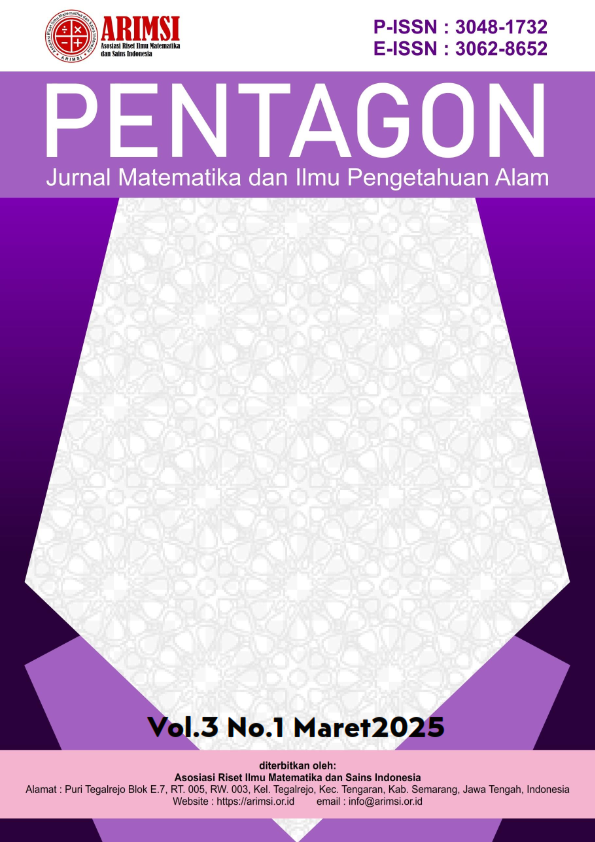Exploring the Potential of Astaxanthin Extracted from Shrimp Shell Waste as a Functional Feed Additive in Duck Nutrition
DOI:
https://doi.org/10.62383/pentagon.v3i2.615Keywords:
astaxanthin, circular economy, duck egg, functional feed, shrimp shell wasteAbstract
Shrimp shell waste is a potential marine biomass resource rich in bioactive compounds such as astaxanthin and chitin, yet remains underutilized in the livestock sector. This study aimed to evaluate the effect of incorporating shrimp shell meal into duck (Anas sp.) feed rations on the yolk color intensity of duck eggs. The experimental design applied a completely randomized design (CRD) with a single factor and four treatments: D0 (100% rice bran, control), A1 (rice bran + 2% shrimp shell meal), A2 (rice bran + 6%), and A3 (rice bran + 10%), with a 21-day observation period. The primary parameter measured was yolk color intensity, assessed visually using a standardized color scale. The results indicated that the addition of shrimp shell meal significantly enhanced yolk color intensity, with the highest pigmentation observed in the A3 treatment. Astaxanthin, functioning as a natural carotenoid pigment, was biologically absorbed and distributed into the yolk via lipophilic pathways, while chitin supported gut health and nutrient absorption efficiency. This study aligns with the principles of the circular economy by valorizing marine processing waste as a functional feed ingredient. A 10% inclusion rate was found to be visually optimal; however, further studies are required to assess its physiological impacts and economic feasibility in broader production contexts.
Downloads
References
Agusta, I. (2021). Ekstraksi Kitosan Dari Limbah Kulit Udang Dengan Proses Deasetilasi. CHEMTAG Journal of Chemical Engineering, 2(2), 38. https://doi.org/10.56444/cjce.v2i2.1935
Dansou, D. M., Zhang, H., Yu, Y., Wang, H., Tang, C., Zhao, Q., Qin, Y., & Zhang, J. (2023). Carotenoid enrichment in eggs: From biochemistry perspective. Animal Nutrition, 14, 315–333. https://doi.org/10.1016/j.aninu.2023.05.012
Food, E., & Authority, S. (2014). Scientific opinion on the safety and efficacy of canthaxanthin as a feed additive for poultry and for ornamental birds and ornamental fish. EFSA Journal, 12(1), 1–24. https://doi.org/10.2903/j.efsa.2014.3527
Geissdoerfer, M., Savaget, P., Bocken, N. M. P., & Hultink, E. J. (2017). The Circular Economy – A new sustainability paradigm? Journal of Cleaner Production, 143(April 2018), 757–768. https://doi.org/10.1016/j.jclepro.2016.12.048
Higuera-Ciapara, I., Félix-Valenzuela, L., & Goycoolea, F. M. (2006). Astaxanthin: A Review of its Chemistry and Applications. Critical Reviews in Food Science and Nutrition, 46(2), 185–196. https://doi.org/10.1080/10408690590957188
Khambualai, O; Yamauchi, K. E; Tangtaweewipat, S; Cheva-Isarakul, B. (2008). Effects of dietary chitosan diets on growth performance in broiler chickens. The Journal of Poultry Science, 45(3), 206–209.
Kojima, S., Koizumi, S., Kawami, Y., Shigeta, Y., & Osawa, A. (2022). Effect of Dietary Carotenoid on Egg Yolk Color and Singlet Oxygen Quenching Activity of Laying Hens. Journal of Poultry Science, 59(2), 137–142. https://doi.org/10.2141/jpsa.0210032
Maharani, N. R., Kurniasih, R. A., & Sumardianto. (2023). Ekstraksi Astaxanthin Dengan Suhu Yang Berbeda Dari Karapas Udang Vaname (Litopenaeus Vannamei) Menggunakan Pelarut Minyak Kelapa. Jurnal Ilmu Dan Teknologi Perikanan, 5(1), 26–31.
Marieta, A., Musfiroh, I., & Bandung Sumedang, J. K. (2019). Review Artikel : Berbagai Aktivitas Farmakologi Dari Senyawa Kitosan. 17(4), 105–110.
Okada, S., Nur-E-Borhan, S. A., & Yamaguchi, K. (1994). Carotenoid Composition in the Exoskeleton of Commercial Black Tiger Prawns Shigeru Katsumi Yamaguchi Laboratory of Marine Biochemistry , Faculty of Agriculture , The University of Tokyo , Yayoi , Bunkyo , Tokyo 113 , Japan ( Received Carotenoid content an. Fisheries Science, 60(2), 213–215.
Pertiwi, H., Nur Mahendra, M. Y., & Kamaludeen, J. (2022). Astaxanthin as a Potential Antioxidant to Improve Health and Production Performance of Broiler Chicken. Veterinary Medicine International, 2022. https://doi.org/10.1155/2022/4919442
Prasetyaningsih, A., Najoan, G. C., Wisaksono, A., & Rahardjo, D. (2021). Ekstraksi Astaxanthin Kulit Udang (Litopenaeus vannamei) Pantai Gunung Kidul Menggunakan Pelarut Minyak Bunga Matahari dan Etanol. Biosaintropis (Bioscience-Tropic), 7(1), 33–43. https://doi.org/10.33474/e-jbst.v7i1.384
Rahmalia, W., Adhitiyawarman, A., Prayitno, D. I., & Lubis, Y. N. B. (2024). Aktivitas Antioksidan Ekstrak Astaxanthin dari Limbah Kulit dan Kepala Udang Dogol (Metapenaeus ensis). Jurnal Kelautan Tropis, 27(2), 380–390. https://doi.org/10.14710/jkt.v27i2.22706
Rossi, N., Grosso, C., & Delerue-Matos, C. (2024). Shrimp Waste Upcycling: Unveiling the Potential of Polysaccharides, Proteins, Carotenoids, and Fatty Acids with Emphasis on Extraction Techniques and Bioactive Properties. Marine Drugs, 22(4). https://doi.org/10.3390/md22040153
Sunarno, S., Budiraharjo, K., & Solikhin, S. (2021). Analisis Efek Pemeliharaan Sistem Intensif dan Ekstensif terhadap Produktivitas dan Kualitas Telur Itik Tegal. Jurnal Peternakan Indonesia (Indonesian Journal of Animal Science), 23(2), 83. https://doi.org/10.25077/jpi.23.2.83-93.2021
Yani, N. F., & Elisia, R. (2024). Pengembangan Industri Peternakan Itik Petelur Di Indonesia Dan Global ( Overview Of Production And Development Challenges Of The Layer Ducks Farming Industry In Indonesia And Globally ). 2, 2–11.
Zhao, Y. C., Li, X. Y., Wang, C. C., Yang, J. Y., Xue, C. H., Zhang, T. T., & Wang, Y. M. (2023). Free astaxanthin-rich diets enhanced astaxanthin accumulation in egg yolks compared to esterified astaxanthin-rich diets. Food Chemistry, 405(November 2022), 266003. https://doi.org/10.1016/j.foodchem.2022.134872
Downloads
Published
How to Cite
Issue
Section
License
Copyright (c) 2025 Pentagon : Jurnal Matematika dan Ilmu Pengetahuan Alam

This work is licensed under a Creative Commons Attribution-ShareAlike 4.0 International License.





